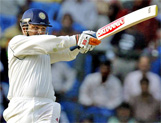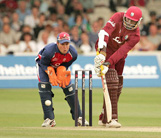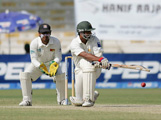ARTICLES
On the Back-Foot and Behind - Batting - Part IV
- By Polly Umrigar
THE PULL
The Pull should be attempted to a ball that is pitched short. No batsman should attempt to pull a ball that is over pitched or of good length, as this will lead to disaster.In executing this shot, one has to go back and across with the right foot so that the right toe is pointing almost straight down the pitch towards the bowler. Then as the ball comes along, it should be pulled hard to mid-wicket, at the same time pivoting the body, keeping the legs fairly apart and rolling the wrists over to keep the ball on the ground. This stroke is particularly effective against leg-break and off-break bowlers.
THE HOOK

Virender Sehwag
essays the hook shot
The hook shot could be applied to a
ball delivered with some speed, pitched short either on the stumps or on the
leg-side.
The batsman should 'hook' the ball behind square-leg after stepping inside the line of flight. To play the hook, he should move back and across with the right foot and as the ball rises towards his chest or shoulder, swing it away somewhere between square-leg and the wicketkeeper. He should not try to hit the ball very hard as there is every chance of his mistiming the same and offering a catch.
The batsman should 'hook' the ball behind square-leg after stepping inside the line of flight. To play the hook, he should move back and across with the right foot and as the ball rises towards his chest or shoulder, swing it away somewhere between square-leg and the wicketkeeper. He should not try to hit the ball very hard as there is every chance of his mistiming the same and offering a catch.
FORCING SHOT OFF THE BACK FOOT
A ball short of a good length that is pitched on the stumps and is not short enough to pull, can be 'forced' off the back foot past the bowler.It is a relatively safe shot, but demands great power from the wrists and forearms and immaculate timing. The initial movement is similar to that for a back defensive stroke, except that the right foot should be taken backwards rather straighter. This is to lend more power to the shot. The left hand becomes really a guide. Power is generated from the right hand in co-ordination with the wrists and forearms.
This shot is usually essayed while trying to play the ball back past the bowler. It can also be dispatched to wide of mid-on by hitting slightly across the line. It can also be played in the cover- extra cover region.
LEG-GLANCEST
There are two leg-glancesI. BACKWARD LEG-GLANCE:
A batsman should attempt this shot if he is confident that the ball will pass clear of the leg-stump if it misses the bat. Otherwise, he will run the risk of being out leg-before wicket.

Chris Gayle demonstrates the left-hander's version of the forward leg-glance in a
one-dayer against England.
The right foot should be moved back
and across in front of the stumps with the right toe pointing down the pitch.
Contact should be made with the ball a few inches in front of the left leg.
This acts as a useful safeguard against a possible catch by the wicketkeeper if the shot is played too fine.
Here, the left hand plays the part of keeping the handle slightly in front of the blade (tilted), and the right hand dictates the turning movement of the bat to acquire the required deflection. Dropping the right hand down the handle at the moment of impact will enable the batsman to control the stroke better.
This acts as a useful safeguard against a possible catch by the wicketkeeper if the shot is played too fine.
Here, the left hand plays the part of keeping the handle slightly in front of the blade (tilted), and the right hand dictates the turning movement of the bat to acquire the required deflection. Dropping the right hand down the handle at the moment of impact will enable the batsman to control the stroke better.
II. FORWARD LEG-GLANCE
A forward leg glance demands that the ball should be a half-volley or fuller than a good length. The posture is the same as that for the on-drive, except that here the bat turns at the moment of impact and deflects the ball behind the wicket, as opposed to the on-drive that is played with a straight bat.
The head and shoulder should be kept forward and down, the bat inclined forward, hands ahead of the blade to make sure that the ball is glanced downwards and not in the air. If desired, the right hand may go down the handle to assist control.
THE SWEEP

Pakistan's Yousuf Youhana executes the sweep in a Test match against Sri Lanka
The sweep is played simply by
advancing the front leg down the pitch and swinging at the ball with almost a
horizontal bat so that the ball will in effect be 'swept' behind square-leg.
The ball should be hit along the ground and this is achieved by rolling the wrists over at the time of execution of the stroke, and by keeping the bat slightly over the line of flight.
While playing this shot, one must make sure that front foot is correctly positioned, especially when facing a leg-spin bowler.
The ball should be hit along the ground and this is achieved by rolling the wrists over at the time of execution of the stroke, and by keeping the bat slightly over the line of flight.
While playing this shot, one must make sure that front foot is correctly positioned, especially when facing a leg-spin bowler.